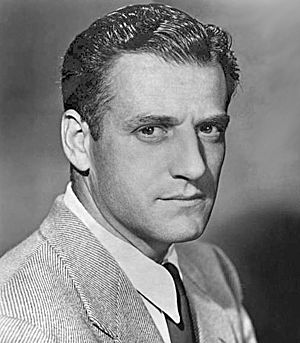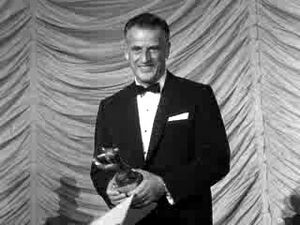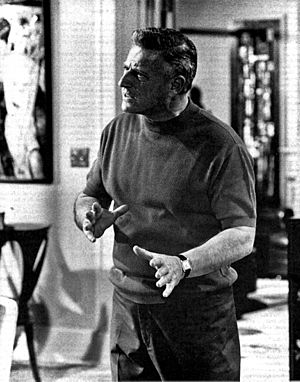Stanley Kramer facts for kids
Quick facts for kids
Stanley Kramer
|
|
|---|---|

Kramer in 1955
|
|
| Born | September 29, 1913 New York City, U.S.
|
| Died | February 19, 2001 (aged 87) Los Angeles, California, U.S.
|
| Occupation |
|
| Years active | 1933–1997 |
| Spouse(s) |
|
| Children | 4 |
Stanley Earl Kramer (September 29, 1913 – February 19, 2001) was an American film director and producer. He was known for making many of Hollywood's most famous "message films." These were movies that focused on important social issues. Kramer called his films heavy dramas.
As an independent producer and director, he brought attention to topics that many big studios avoided. His films covered subjects like:
- Racism (in The Defiant Ones and Guess Who's Coming to Dinner)
- Nuclear war (in On the Beach)
- Greed (in It's a Mad, Mad, Mad, Mad World)
- The debate between creationism and evolution (in Inherit the Wind)
- The causes and effects of fascism (in Judgment at Nuremberg)
Other famous films he was involved with include High Noon (1952, as producer) and The Caine Mutiny (1954, as producer).
Famous director Steven Spielberg called Kramer an "incredibly talented visionary" and "one of our great filmmakers." He was praised not just for the art in his movies, but for how he made people think about the world. Kramer was known for being very independent as a producer-director.
Even though critics sometimes had mixed feelings about his films, Kramer's work won many awards. This included 16 Academy Awards (Oscars) and 80 nominations. He was nominated nine times as either a producer or director. In 1961, he received the Irving G. Thalberg Memorial Award, a special Oscar for producers. In 1998, he won the first NAACP Vanguard Award for the strong social themes in his movies. The Stanley Kramer Award was created in 2002 to honor films that show important social issues.
Contents
Early Life and Education
Stanley Kramer was born in New York City. His parents were Jewish. They separated when he was very young, so his grandparents often took care of him. His mother worked for Paramount Pictures, a big movie studio. His uncle, Earl Kramer, worked in film distribution for Universal Pictures.
Kramer went to DeWitt Clinton High School in the Bronx and graduated at age fifteen. He then went to New York University. He wrote a weekly column for the school newspaper. He graduated in 1933 at age nineteen with a degree in business. After enjoying writing for the newspaper, Kramer was offered a paid internship at 20th Century Fox in Hollywood. He had planned to go to law school before this opportunity.
Starting a Film Career
Moving to Hollywood and Early Jobs
During the Great Depression, Kramer took many different jobs in the film industry. He moved furniture on movie sets and cut film at MGM. He also worked as a writer and researcher for Columbia Pictures and Republic Pictures. These early jobs helped him learn a lot about how films are made and edited. He became very good at understanding the structure of movies.
In 1943, during World War II, Kramer joined the Army. He helped make training films with the Signal Corps in New York. Other famous Hollywood filmmakers like Frank Capra also worked there. He left the army as a first lieutenant.
After the war, it was hard to find jobs in Hollywood. So, in 1947, Kramer started his own film company called Screen Plays Inc. He teamed up with writer Herbie Baker, publicist George Glass, and producer Carl Foreman. They believed that the big studios were not keeping up with new ideas. They thought there was a chance to make independent films.
Becoming a Producer
Kramer's new company could rent unused film studios. This allowed him to make independent films for much less money than the big studios. He could also make movies about subjects that the larger studios usually avoided.
However, getting money for these independent films was a big challenge. He had to get loans from banks or find private investors. Many other independent companies were also trying to get money at this time.
The first movie his company produced was the comedy So This Is New York (1948). It did not do well at the box office. But his next film, Champion (1949), was a huge success. It was about an ambitious boxer and starred Kirk Douglas. The movie was filmed in only 23 days with a small budget. It won an Oscar for Best Editing and was nominated for four other awards.
Kramer then produced Home of the Brave (1949). This film was even more successful than Champion. It was about the unfair treatment of a Black soldier in the army. This topic was very sensitive at the time. Kramer filmed it in secret to avoid protests. Critics generally liked the film, calling it "courageous."
His company, now called Stanley Kramer Company, produced The Men (1950). This film was Marlon Brando's first movie role. It was a drama about soldiers who became paralyzed in the war. It was another success for Kramer, dealing with a unique and important subject.
Also in 1950, Kramer produced Cyrano de Bergerac. This was the first English-language film version of the famous French play. It made José Ferrer a star, and he won an Oscar for Best Actor.
Working with Columbia Pictures
In 1951, Harry Cohn, the president of Columbia Pictures, offered Kramer a deal. Kramer's company would work with Columbia and he would have freedom to choose his films. He also got a budget of almost a million dollars for each movie. Kramer agreed to make 20 films over five years. However, he later said this was a "dangerous" decision. He agreed because he really wanted to direct films and liked having steady money from a studio.
His last independent film was High Noon (1952), a Western drama. It won four Oscars. Around this time, there was a difficult period in Hollywood called McCarthyism. Carl Foreman, who wrote and produced High Noon, was questioned by a government committee. He had been part of the Communist Party years earlier. Because he refused to name other people, he was put on a "blacklist" by Hollywood companies. Kramer, who was Foreman's friend and business partner, removed Foreman's name from the film's co-producer credits.
Kramer continued to produce movies at Columbia. These included Death of a Salesman (1951) and The Wild One (1953). Even with bigger budgets, many of his next films lost money, though some were still highly praised.
In 1953, Kramer and Cohn ended their contract early. However, Kramer's last Columbia film, The Caine Mutiny (1954), earned back all the money Columbia had lost on his earlier projects.
Becoming a Director
After The Caine Mutiny, Kramer left Columbia. He went back to making independent films, but this time he also directed them. For the next 20 years, Kramer became known for directing successful films about social and controversial issues. These included racism, nuclear war, greed, and the effects of fascism. Critic Charles Champlin said Kramer "took on social issues when it was not popular to do so in Hollywood."
Some of these films were The Defiant Ones (1958), On the Beach (1959), Inherit the Wind (1960), Judgment at Nuremberg (1961), and Guess Who's Coming to Dinner (1967). He also directed the comedy It's a Mad, Mad, Mad, Mad World (1963).
His first film as director was Not as a Stranger (1955). It was a story about medical students. The film was a big hit, but reviews were mixed.
The Pride and the Passion (1957)
The Pride and the Passion (1957) was based on a novel by C. S. Forester. It showed a group of Spanish fighters trying to move a giant cannon to defeat Napoleon's army. It starred Frank Sinatra, Cary Grant, and Sophia Loren.
The Defiant Ones (1958)
The next year, Kramer directed The Defiant Ones (1958). This film was about two escaped prisoners in the Southern U.S., one Black (Sidney Poitier) and one white (Tony Curtis). They are chained together, which forces them to work together despite their differences.
New York Times film critic Bosley Crowther praised the film. He called it a "dramatic visualization of a social idea—the idea of men of different races brought together to face misfortune in a bond of brotherhood." It was nominated for eight Oscars and won two.
Years later, the film was shown at the Moscow Film Festival. Kramer and Sidney Poitier attended. People there loved the film and chanted "Kraaaamer!"
On the Beach (1959)
With On the Beach (1959), Kramer tackled the serious topic of nuclear war. The film takes place after World War III has destroyed most of the Northern part of the world. Radioactive dust is heading towards Australia. Kramer made the film look like a documentary, showing empty cities. It starred Gregory Peck, Ava Gardner, Fred Astaire, and Anthony Perkins.
Most reviews were positive, even from scientists. Critics admired Kramer for being brave enough to make a film about such a difficult subject.
Inherit the Wind (1960)
Inherit the Wind (1960) was another challenging film for Kramer. It dealt with the heated topics of creationism and evolution being taught in schools. The film was based on a play and was a fictionalized version of the 1925 Scopes Trial. This trial was about a law in Tennessee that made it illegal to teach human evolution in state-funded schools.
The film starred Spencer Tracy as the lawyer defending the teacher (Clarence Darrow) and Fredric March as the lawyer who believed only creationism should be taught (William Jennings Bryan). It was nominated for four Oscars. Spencer Tracy was nominated for Best Actor. He said, "Everybody tells me how good I am, but only Stanley gives me work."
The film received great reviews but did not do well at the box office. Some religious groups called the film "anti-God." Kramer said this film was part of a "trilogy of controversial pictures," along with The Defiant Ones and On the Beach.
Judgment at Nuremberg (1961)
Like his previous film, Judgment at Nuremberg (1961) was a fictional story based on a real event. This film was about the Nuremberg Trials, which happened after the Nazis were defeated in World War II. It also starred Spencer Tracy as the main judge, along with many other famous actors. Maximilian Schell won an Oscar for Best Actor, and Abby Mann won for Best Screenplay. The film was nominated for 11 Oscars.
Reviews were very positive. Critics praised Kramer for being in control of the story and adding to the importance of American films. However, the film also shocked and angered some people when it premiered overseas, especially in Germany. Kramer said the premiere in Berlin was "the most frightening evening in my life."
Before filming, Kramer and the screenwriter made all the actors and crew watch films taken by American soldiers when they freed people from concentration camps.
It's a Mad, Mad, Mad, Mad World (1963)
After making so many serious films, Kramer felt he needed to make something lighter. So, he directed It's a Mad, Mad, Mad, Mad World (1963). This film was a comedy about greed, featuring many famous comedians. Kramer wanted to prove he could direct comedies. He hired actors from silent film stars like Buster Keaton to newer talents like Jonathan Winters.
The film received mixed reviews. Some thought it had too many comedians and lost its focus. However, it was Kramer's biggest box office hit. The public enjoyed its funny and chaotic story. It was nominated for six Oscars and won for Best Sound Editing.
Ship of Fools (1965)
Ship of Fools (1965) was like a "floating Grand Hotel" because it also had an all-star cast. The story follows the relationships of passengers on a ship returning to Germany in 1933, when Nazism was rising. The film explored social and psychological themes. It won two Oscars and was nominated for six others.
Some people saw the film as showing the "weakness of the world that permitted the rise of Hitler." Kramer agreed, saying that even though Hitler was not mentioned, his rise was always present. Most passengers were Germans returning home when many others were trying to escape Germany.
Guess Who's Coming to Dinner (1967)
For his fourth film about racism, Kramer directed and produced Guess Who's Coming to Dinner (1967). This was a groundbreaking story about a marriage between a Black man and a white woman. It starred Spencer Tracy, Sidney Poitier, and Katharine Hepburn. The film won two Oscars and was nominated for eight. It is considered one of the top 100 films of the last 100 years by the American Film Institute. Despite its popularity, many critics gave it negative reviews.
For Kramer and the cast, this film was very important. It was one of the first films to deal with interracial marriage since the 1920s. No one else wanted to touch this "explosive" social issue until Kramer did.
This was also the last film for Spencer Tracy, who was very ill during filming and died a few weeks after it was finished. It was his fourth film directed by Kramer and his ninth with Katharine Hepburn. Kramer called Tracy "the greatest actor I ever worked with."
The film's success helped change how Hollywood marketed movies. It showed that films with Black lead actors could do well everywhere, even in the Southern U.S. After this, the presence of Black actors was no longer seen as a problem for film marketing. However, Kramer was bothered by the negative reviews. He wanted to be seen as an important film artist. He went on a speaking tour to colleges to show the film and discuss racial integration. But college students often preferred to talk about newer, less traditional films.
Guess Who's Coming to Dinner was Kramer's last big success. His later films did not make much money and received mixed reviews. Some of these films included The Secret of Santa Vittoria (1968) and Oklahoma Crude (1973). Kramer won the Golden Prize for Direction at the 8th Moscow International Film Festival for Oklahoma Crude.
Later Life and Legacy
In the 1980s, Kramer retired to Bellevue, Washington. He wrote a movie column for The Seattle Times from 1980 to 1996. He also hosted his own weekly movie show on television station KCPQ.
In 1997, Kramer published his autobiography, A Mad Mad Mad Mad World: A Life in Hollywood.
He passed away on February 19, 2001, in Los Angeles, at age 87, after getting pneumonia. He was married three times and had four children.
Kramer has been called a "genuine original" as a filmmaker. He made movies he believed in and tried to balance art with making money for over 30 years. Most of his films were known for making audiences think about political and social issues of the time. He said he was "emotionally drawn to these subjects" and believed independent films could bring "vitality to the motion picture industry."
Film author Bill Nichols says Kramer's films continued a Hollywood tradition of combining important issues with drama. Kramer was one of the few filmmakers to explore civil rights issues. His wife, Karen Kramer, said he "put his reputation and finances on the line to present subject matter that meant something." He even gave up his salary to make sure Guess Who's Coming to Dinner was completed.
However, not everyone praised him. Some critics called his films "message movies" and "melodramas." But they also admitted his films had "redeeming social importance" and were "excitingly modern, relevant."
In the 1960s, Kramer felt that the growing "youth culture" had changed the "artistic landscape." He thought writers and filmmakers were no longer as interested in exploring what it meant to be American. In some cases, Kramer was even accused of being "anti-American" because his films focused on social problems.
Kramer produced and directed 23 different actors who were nominated for Oscars. Four of them won: José Ferrer, Gary Cooper, Maximilian Schell, and Katharine Hepburn. Kramer was one of the first stars to be added to the Hollywood Walk of Fame on March 28, 1960.
One of his daughters, Kat Kramer, co-produces documentaries that focus on social issues, as part of her series Films That Change The World.
The Stanley Kramer Award
The Producers Guild of America created the Stanley Kramer Award in 2002. This award honors a film or person whose work highlights important social issues and raises public awareness.
Filmography
As Producer and Director
|
As Producer Only
|
Academy Award Nominations
| Year | Award | Film | Resulting Win |
|---|---|---|---|
| 1952 | Best Picture | High Noon | Cecil B. DeMille – The Greatest Show on Earth |
| 1954 | The Caine Mutiny | Sam Spiegel – On the Waterfront | |
| 1958 | The Defiant Ones | Arthur Freed – Gigi | |
| Best Director | Vincente Minnelli – Gigi | ||
| 1961 | Best Picture | Judgment at Nuremberg | Robert Wise – West Side Story |
| Best Director | Jerome Robbins and Robert Wise – West Side Story | ||
| Irving G. Thalberg Memorial Award | Won | ||
| 1965 | Best Picture | Ship of Fools | Robert Wise – The Sound of Music |
| 1967 | Guess Who's Coming to Dinner | Walter Mirisch – In the Heat of the Night | |
| Best Director | Mike Nichols – The Graduate | ||
See also
 In Spanish: Stanley Kramer para niños
In Spanish: Stanley Kramer para niños



